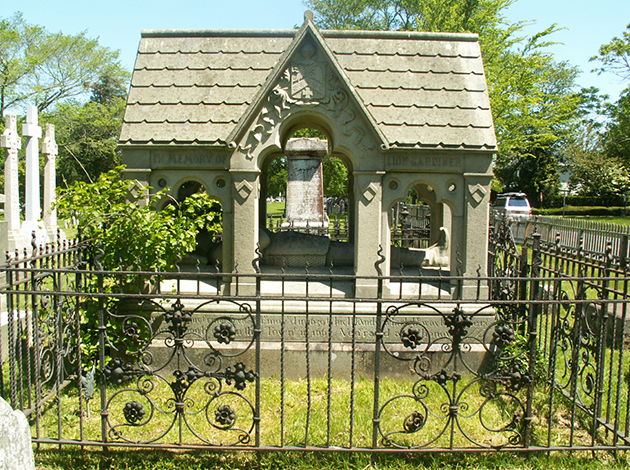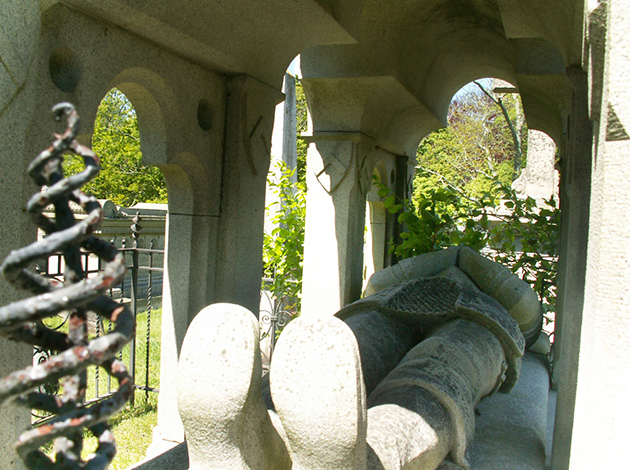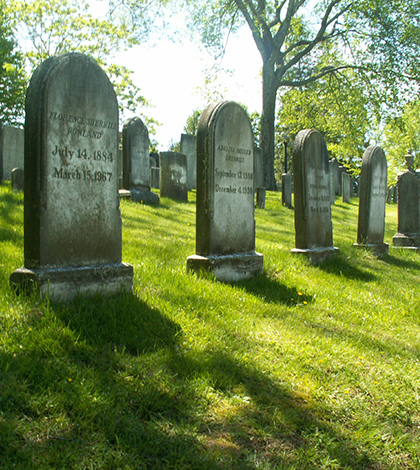
It’s hard to enter East Hampton without passing its founding members. The oldest burial ground in East Hampton, the South End Cemetery has tombstones that date back to the 17th century. Here, only three steps down off Main Street, you’ll find shipwreck victims, socialites, artists, soldiers, an accused witch and East Hampton’s most prominent resident, Lion Gardiner, who now lies in a sarcophagus surrounded by pillars nearly four feet high.
Gardiner was born in England in 1599 and died in East Hampton in 1663. A military engineer, he was hired to oversee construction of fortifications in the new colony in 1635. By 1639, he was the owner of what is known today as Gardiners Island. His is one of the oldest graves, but his tombstone is relatively new, erected in 1886 and designed by James Renwick, Jr., the architect behind St. Patrick’s Cathedral in Manhattan and the Smithsonian Institution Building in Washington, D.C.
An above-ground casket with a representation of the deceased carved in stone, sarcophagi are mostly associated with Ancient Egypt, used to protect royal mummies. Gardiner’s sarcophagus, a knight in complete armor, is the only one in the South End Cemetery.
The inscription reads, “In memory of Lion Gardiner, an officer of the English army, and an engineer and master of Works of Fortification in ye Leaguers of ye Prince of Orange in ye Low Countries in 1635. He came to New England in ye service of ye Company of Lords and Gentlemen. He builded and commanded ye Saybrook Forte. After accomplishing his term of service he removed in 1663, to his island of which he was sole owner and ruler. Born in 1599, he died in this town in 1663 venerated and honored.”

Generations of Long Islanders going back to the 1600s rest here, some of their headstones unreadable, cracked and covered with moss. An obelisk, a stone pillar with a pyramidal top, marks the graves of those who died in the 1858 John Milton shipwreck off Montauk.
The grave of wealthy couple Sara and Gerald Murphy also sits at South End. The Murphys were the subject of Calvin Tomkins’ biography Living Well is the Best Revenge and they were F. Scott Fitzgerald’s inspiration for Nicole and Dick Driver in Tender Is the Night.
Many believe Goody Elizabeth Garlick, accused and acquitted of witchcraft in 1658, is also buried here in an unmarked grave.
Garlick, then in her 50s, was accused of bewitching and killing the daughter of her employer, who just happened to be Lion Gardiner, as well causing the deaths of several infants in the neighborhood, according to village records. The case, including depositions, takes up several pages in the printed records of East Hampton. Like the Salem Witch Trials, the trial was based on hearsay and lies.
Garlick was sent to the General Court of Connecticut, since East Hampton was then within the jurisdiction of that colony. The jury found Garlick not guilty on account of lack of evidence. Her date of death has not been found, and her burial place remains a mystery.

One of the oldest original headstones in South End is that of Pastor Thomas James, who died in 1696. His dying request was that his headstone would face the opposite direction of those around him so he could confront his accusers on Resurrection Day. It remains backward three centuries later.
These are just a handful of colorful residents who reside in South End, just steps away from the art galleries and high-end shops of Main Street. So next time you pass Town Pond, pull over for a glimpse into the past.
For more tales of East Hampton residents who are interred at the South End Cemetery, read “In olde New York,” written by Charles Burr Todd in 1907. Hugh King, East Hampton historian and “Town Crier,” gives tours of the cemetery for the East Hampton Historical Society. For details visit www.easthamptonhistory.org.


































